The Ultimate Software-Defined Storage Solution
NexentaStor stands as the industry's leading software-defined storage (SDS) platform, empowering enterprises with robust and comprehensive unified block and file storage services. With its latest version 5, NexentaStor has gained the trust of thousands of customers, serving configurations ranging from tens of terabytes to multiple petabytes. It has proven to be the go-to solution, replacing traditional storage area network (SAN) and network attached storage (NAS) hardware appliances.
What sets NexentaStor apart is its software-centric approach. Unlike traditional storage vendors' hardware appliances, NexentaStor is delivered as highly adaptable software. It can be seamlessly deployed on industry-standard x86 servers, directly connected to shared SAS storage enclosures and devices, or as a virtual machine on a wide range of hypervisors, whether on-premises or in public clouds. This flexibility grants users unparalleled versatility in their storage infrastructure.
NexentaStor 5 introduces a cutting-edge management framework that offers an extensive set of developer-friendly and self-documenting REST APIs. These APIs serve as the foundation for all user management interfaces, including the command-line interface (CLI) and graphical user interface (GUI), as well as ecosystem plugins. This framework empowers users to leverage the full potential of NexentaStor, enabling seamless integration and customization.
To streamline multi-system deployments, NexentaFusion comes bundled with NexentaStor 5. NexentaFusion provides a centralized management interface, offering a comprehensive view of all connected systems. With this single pane of glass management, administrators can effortlessly oversee and control their entire storage infrastructure.
By delivering NexentaStor as software-only, customers benefit from unprecedented levels of flexibility and performance. The elimination of hardware lock-in translates into significant cost savings, allowing organizations to optimize their storage investments. Moreover, storage management and scalability are simplified, empowering users to effortlessly adapt and expand their storage environment as their needs evolve.
Unlock the full potential of your data with NexentaStor, a comprehensive and high-performance storage platform that offers standard file and block protocol services. Whether you require file-level access with NFS and SMB or block-level access with FC and iSCSI, NexentaStor has got you covered.
Deployed as a full-fledged storage operating system, NexentaStor seamlessly integrates with standard x86 bare metal servers or can be run as virtual machines in private or public clouds. This unmatched flexibility allows you to tailor your storage infrastructure to your specific needs, whether on-premises or in the cloud.
NexentaStor supports both single-node and dual-node high-availability (HA) cluster configurations. In a single-node setup, you can utilize internal devices for storage, while the dual-node configuration leverages SAS-connected shared backend devices. This redundancy ensures optimal performance and data availability, safeguarding your critical information.
At the core of NexentaStor lies the powerful OpenZFS file system, an open-source technology known for its reliability and performance. By harnessing the capabilities of OpenZFS, NexentaStor delivers enterprise-class data services that surpass traditional storage appliance vendors. Say goodbye to legacy systems and embrace a future-proof storage solution that meets the demands of modern data-intensive environments.
NexentaStor
|
||
| Feature | Description | |
| Protocols: | File: NFSv3, NFSv4, SMB 1.0, SMB 2.1, SMB 3 Block: Fibre Channel, iSCSI |
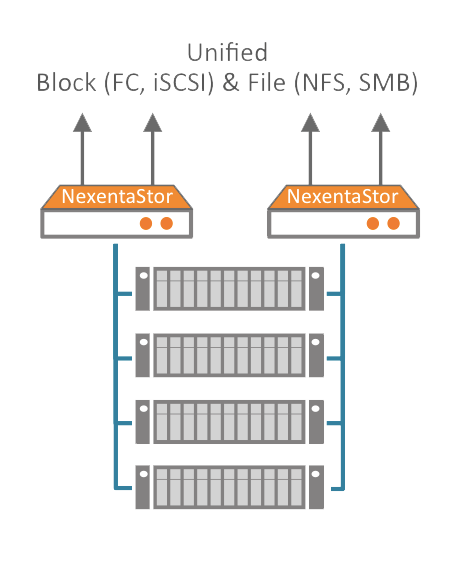 |
| Configurations: | Single node – x86 bare metal Dual-node High Availability clusters – x86 bare metal MetroHA Stretched clusters – x86 bare metal Virtual Storage Appliance – VMware ESXi, KVM Amazon Web Services |
|
| Data Management: | All-Flash, Hybrid, or All-Disk pools RAID 10, N+1, N+2, N+3 OpenZFS end-to-end data integrity Unlimited snapshots & clones Unlimited file system size High performance inline data reduction Thin provisioning Storage Quality of Service Snapshot based Scheduled Replication Continuous Asynchronous Replication |
|
| Management: | Self documenting REST API, CLI, SNMP NexentaFusion (HTML 5 based) | 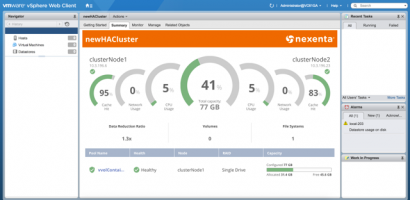 |
| Client OS Support: | VMware ESXi, Microsoft Windows, CentOS, RHEL, Ubuntu | |
| Ecosystem Integration: | SMB 3 ODX for Microsoft Hyper-V, VMware VAAI Block, VMware Virtual Volume (VVOL) 2.0, VMware vCenter Plugin, VMware Site Recovery Manager, OpenStack Cinder & Manila, Docker Volume Plugin, Kubernetes Persistent Volume | |
NexentaStor Use Cases
This mature set of features has allowed Nexenta to successfully sell into a wide variety of market verticals and use cases, from high-performance low-latency all-flash arrays supporting virtual environments and business-critical applications, all the way to large-scale cost-optimized backup and
archive repositories.

The ability to select the right hardware configuration for the right workload gives customers maximum flexibility. Having the same software stack running on high-performance all-flash, balanced hybrid and cost- optimized backup and archive setups simplifies data movement across tiers and management of the full storage infrastructure.
The ability to select the right hardware configuration for the right workload gives customers maximum flexibility. Having the same software stack running on high-performance all-flash, balanced hybrid and cost- optimized backup and archive setups simplifies data movement across tiers and management of the full storage infrastructure.
NexentaStor Software Architecture
NexentaStor 5 builds on the open source OpenZFS file system for its core data services and complements it with high performance block and file services, high-availability clustering, kernel based multi-site replication and the Nexenta Management Framework (NMF). As shown in the figure below, NMF provides a tight cover on the underlying storage operating system and handles all provisioning and management operations. From a user perspective, NMF presents an exhaustive self-documenting REST API that provides a consistent foundation for the system’s Command Line Interface (CLI), the NexentaFusion graphical user interface and all supported ecosystem plugins.
NexentaStor High Level Architectur
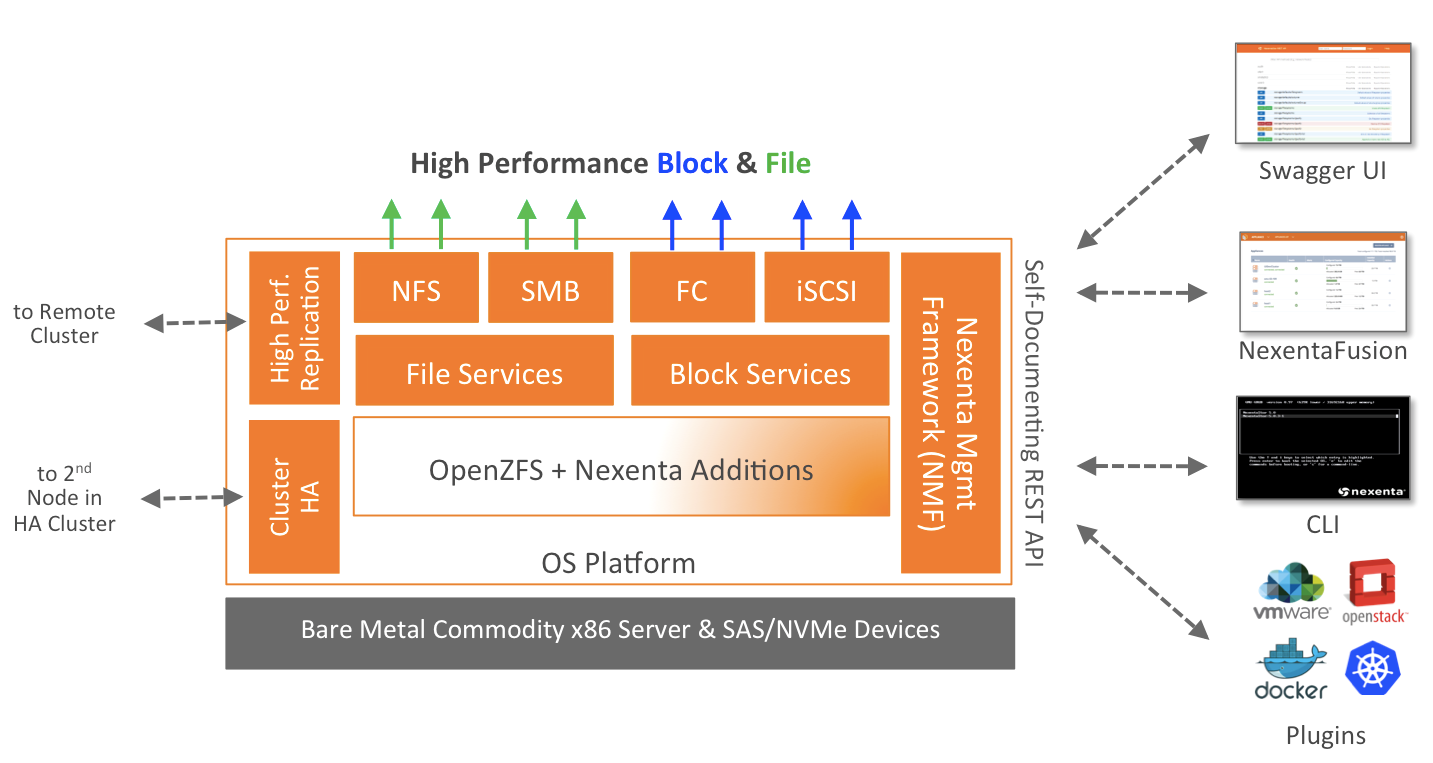
NexentaStor 5 benefits from all the scalability, performance, and reliability improvements in the core platform that were implemented over the last few years in NexentaStor 4. NexentaStor 5 also incorporates a number of new and enhanced device drivers, adding support for 25Gb/s and 40 Gb/s Ethernet interfaces, as well as 32 Gb/s Fibre Channel HBAs.
The Nexenta Management Framework was first introduced with NexentaStor 5.0 and fully replaced the legacy Nexenta Management Server (NMS), Nexenta Management Console (NMC), and Nexenta Management View (NMV) that were part of NexentaStor 4.x and all previous releases.
By design, NMF is a high-performance, multi-threaded, fault-tolerant management plane that provides a streamlined and simplified storage-centric management experience. Building the NexentaStor CLI as well as all management products on top of the NMF REST API ensures that all operations and all statistics available through the CLI and GUI are supported via the REST API.
NexentaStor REST API Management Screen
The NexentaStor REST API is self-documenting and provides an interactive Swagger user interface for developers and technology partners looking to build storage automation and orchestration.
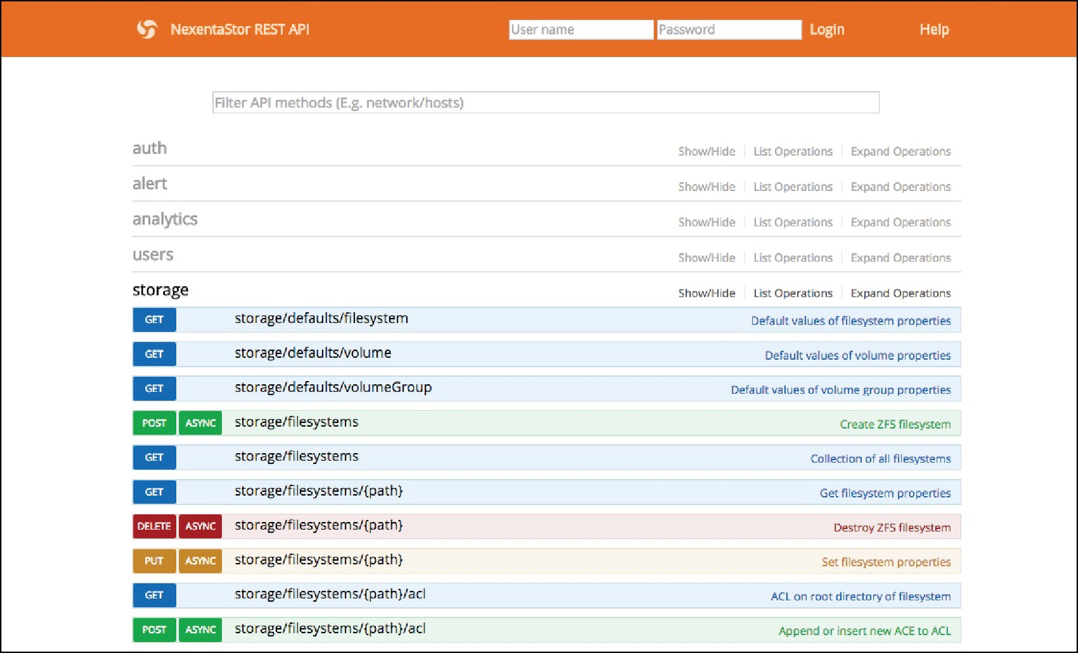
Day to day management operations are accomplished using the NexentaFusion management server, freely available with any NexentaStor 5 license. NexentaFusion complements any NexentaStor 5 deployment and provides a single pane of glass Graphical User Interface for multiple NexentaStor appliances. NexentaFusion is available as a VMware OVA and as a Docker container for simple deployment on any Linux host, physical or virtual. It incorporates intuitive workflows for all provisioning
and fault management tasks and delivers advanced analytics dashboards for detailed monitoring and troubleshooting, storing up to two years of historical service data.
NexentaFusion Management Screen
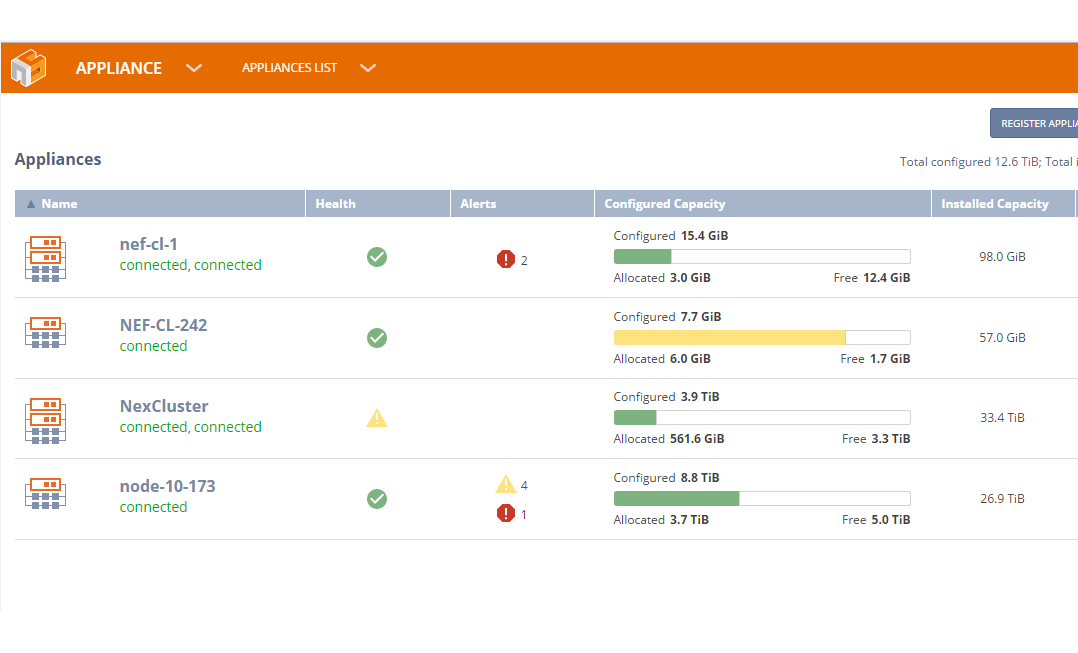
NexentaStor High Availability
NexentaStor high availability (HA) allows you to configure two NexentaStor nodes to provide redundant access to storage pools. Active-passive (two NexentaStor nodes, one pool) and active-active (two nodes, two pools or more) configurations are supported. If a node is unable to deliver storage services for some reason, the other node automatically takes over. Technically, a NexentaStor HA configuration consists of an HA cluster where one or more HA services are running:
- An HA cluster is a pair of NexentaStor nodes that share access to backend storage devices, have
network connectivity to each other, and on which the high availability feature is enabled. - An HA service specifies the Virtual IP (VIP) address(es) or Fibre Channel ports for the HA cluster,
the storage pool(s) to be protected, and which of the nodes initially provides clients access to the
storage.
To facilitate HA configuration for file and iSCSI services, each node should have at least one static IP address assigned to it, and each VIP should have its own static IP address.
Example NexentaStor High Availability Configuration
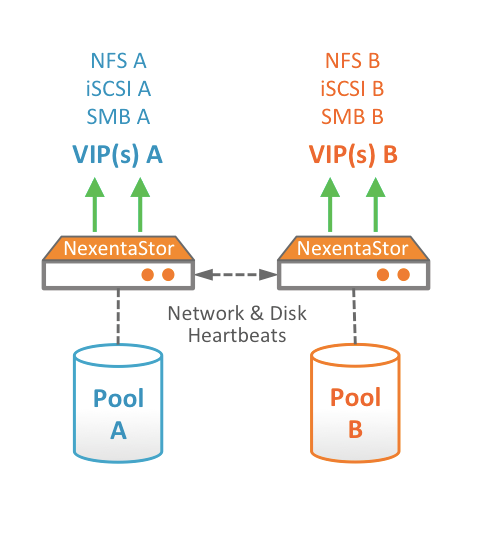
In this example, Node-A and Node-B comprise an HA cluster. There are two storage pools, Pool-A and Pool-B, that consist of backend storage devices that are accessible to both nodes in the HA cluster. There are two HA services in this configuration: one that provides access to Pool-A using VIP-A and another that provides access to Pool-B using VIP-B. In this example, Node-A serves as the backup for Pool-B, and Node-B serves as the backup for Pool-A. Node-A and Node-B exchange status information using a number of different network and storage heartbeat mechanisms. If all of the heartbeat mechanisms are disrupted for a given length of time, then the main node is considered to have failed, and the backup node takes over. In this example, failure of Node-A would lead to Node-B taking over Pool-A and VIP-A, and failure of Node-B would lead to Node-A taking over Pool-B and VIP-B.
Once the failed node is restored, it can take back its storage pool. You can configure this to occur automatically when the node comes back online, or you can do this manually.
Please contact the Zstor Sales Team for more information per E-Mail:


